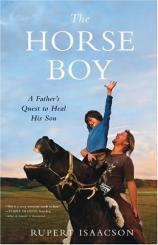The Horse Boy: A Father’s Quest to Heal His Son
Review
The Horse Boy: A Father’s Quest to Heal His Son
If you are a parent of a child with autism, if you are an educator, a psychologist or a therapist whose work involves autistic children, this book will astound you. It is honest, bold, touching and radical. It suggests the possibility for a healing of many of the characteristics of autism that cause such despair --- the tantrums, the screams, the incontinence, the lack of relatedness. It suggests that autistics may be gifted in some way, and not in need of a total cure, just a re-patterning of their most socially unacceptable behavior. It suggests something like a miracle, but a miracle wrought of extreme effort and great love.
The writer is himself remarkable: a South African raised in the U.K., author of THE HEALING LAND, and successful advocate for the rights of the San people to their traditional lands. In THE HORSE BOY, Rupert Isaacson recounts his search for a cure for his six-year-old autistic son Rowan. With Rowan and his wife Kristin, Isaacson traveled to the far reaches of Mongolia and Siberia seeking out shamanistic aid for the boy’s distressing and at times completely unmanageable symptoms.
Rowan would scream piercingly if he didn’t have his toy animals, was bowel incontinent, and would rush at other children and knock them down. He rarely conversed, just echoing and repeating, sometimes simply babbling. He seemed miserable until he met a horse named Betsy. His father, an experienced horseman, observed that Rowan had a special ability to communicate with the horse, so they began riding together. After the rides Rowan was noticeably calmer. Isaacson also noticed a change --- more communication --- after Rowan met with shamans from the Kalahari visiting in the U.S. as part of the author’s work. Consulting with autism authority Temple Grandin, Isaacson learned that it could be the rhythm of the horse’s gait that soothed the boy. When Isaacson told her of his grand scheme to take Rowan to Mongolia to connect with the horse people and meet their traditional healers, she encouraged him.
Their six-week-long trek by van and horseback was epic. Rowan at first sought safety in the van, and was reluctant to ride the small Mongolian horses. But amazingly he formed an immediate bond with a little boy, Tomoo, the son of their Mongolian guide. He played with Tomoo in a way he had never done before with other children. And in the presence of shamans, Rowan was noticeably solemn and calm. Rupert and Kristin also had to be healed, it seemed, getting thwacked with sticks by one shaman (who gave Rowan a mere brushing with the same stick). Even the camera crew and guides were swept into the quest for a cure for Rowan, urging and encouraging him and never giving up on the process.
Their hair-raising adventures in the wilds of Mongolia will engage even the most blasé reader. Many times Isaacson questioned his own sanity in trying to bring a disabled, anti-social child on a journey of such physical hardship among people who have no knowledge of the condition of autism as we understand it in the West. But the family found more sympathy and a greater understanding than they could have anticipated from the traditional healers and the ordinary people they encountered.
If Isaacson was not so careful to show us the daily heartbreaks of dealing with a boy like Rowan, so we are sure he was a child whose autistic symptoms were among the worst that a parent has to cope with, we might not be as prone to believe the miraculous nature of the changes that slowly begin to happen for this complex child. Western doctors had warned his parents that there would appear to be progress, followed by total regressions. But the regressions gradually stopped after his encounters with the shamans. Rowan became a conversational, toilet-trained, friendly boy who is still autistic, but no longer demonstrates the violent, frightening aspect that his parents were so determined to have lifted from him. Now that he functions like a typical child, his father has remained involved in his progress by operating a riding stable for children with deficits of the sort Rowan once suffered with.
Not every parent of an autistic child will have the resources that Isaacson obviously did (including a book deal to finance the international trek), which could be frustrating to some readers. But if there is healing to be found with shamans, as many people believe, that is in itself a reason for hope. The healers who Rowan met predicted that he would be a shaman himself someday. That will perhaps be the next book.
Reviewed by Barbara Bamberger Scott on January 22, 2011
The Horse Boy: A Father’s Quest to Heal His Son
- Publication Date: April 14, 2009
- Genres: Nonfiction
- Hardcover: 368 pages
- Publisher: Little, Brown and Company
- ISBN-10: 0316008230
- ISBN-13: 9780316008235




